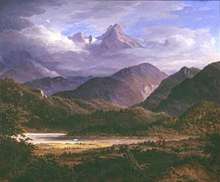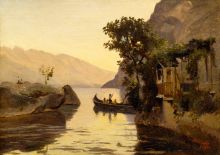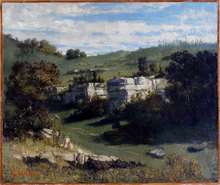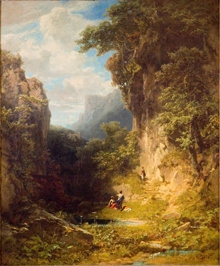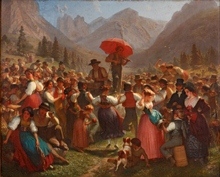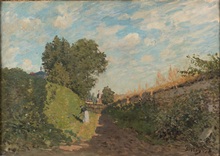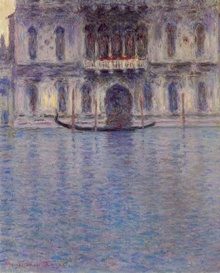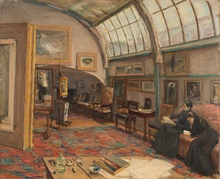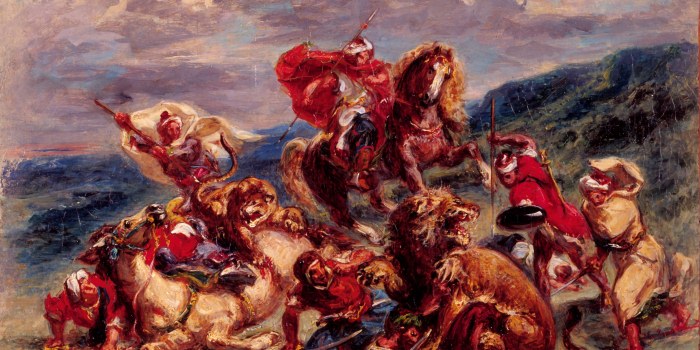
Painting in the nineteenth century
Thanks to the Sturzeneggerschen Gemäldesammlung bequeathed to the City of St. Gallen in 1926 and additional bequests and donations, the Kunstmuseum St. Gallen is able to present crucial cornerstones of French and German painting of the nineteenth century: Delacroix’s Romanticism, Courbet’s Realism, Corot’s plein air painting, Spitzweg’s idyllic scenes, the German-Romans with masterworks by Böcklin and Feuerbach; Impressionism, represented by Monet, Pissarro, Sisley, and Renoir; and Symbolism by Redon.
Romantic – Realism
The poet Novalis grasped Romanticism by declaring, «I romanticize it by giving the commonplace a greater sense; the ordinary, a mysterious appearance; the familiar, the dignity of the unfamiliar; the finite, the gleam of eternity.» Andreas Renatus Högger (1808–1854) visualized this longing for the eternal in the painting Der Watzmann (1832). The Watzmann has inspired romantic feelings for nature more so than any other mountain—even for the then-young artist from St. Gallen whose extensive work group supplements the paintings and drawings by Joseph Anton Koch (1768–1839), Ferdinand Olivier (1785–1841), and Karl Blechen (1798–1840). Flanked by surging hill ranges, the mountain towers threateningly behind a gentle landscape scene: It appears enraptured and can be experienced in sublime grandeur.
Parallel to Delacroix’s innovations, the dissolution of academic rules attained an artistic peak also in the landscape scenes in the oeuvre of Camille Corot (1796–1875), the most significant plein air painter of his generation in France. In 1834, traveling in Italy, he created the view from a narrow rocky bay Landscape near Riva on Lake Garda. In concisely grasped picture details, the morning light unfolds a gentle game on the calm surface of the water and across the ridge. The freshness and immediacy of the «realistic» view of reality is shown in his works, as in those of the other artists of the so-called Ecole de Barbizon—Théodore Rousseau (1812–1867) and Charles-François Daubigny (1817–1878)—represented in the St. Gallen collection with characteristic paintings.
Gustave Courbet (1819–1877), the great realist in nineteenth-century art, was friends with the Barbizon painters. His artistic ambitions, however, went beyond landscape painting. Similar to Jean-François Millet (1814–1874), he depicted contemporary laborers in representative large formats. He describes this as «Realism,» although it is sometimes referred to as «peinture socialiste.» Even his deserted landscapes, such as the one created of majestic trees, Landscape near Ornans (ca. 1851) in Franche-Comté, his hometown, was symbolic for him of regional autonomy with regard to the Parisian centralized power in a political sense, and an individual independence from the academic dictates in an artistic sense. As a member of the Commune, he fled to Swiss exile in 1873, where the impressive late work Sunset on Lake Geneva (1876) arose with an almost unreal, dramatic color mood.
Also familiar with the artistic developments in France was Munich’s late romantic, Carl Spitzweg (1808–1885), often derided as a painter of idyllic scenes, from whom the Kunstmuseum St.Gallen houses an ensemble unique in Switzerland of altogether eight paintings, including the masterpiece Bathing Women in a Ravine (ca. 1868). Two women are just about to undress when a third joins, disturbing them—while the beholder can follow the idyllic scene as voyeur, from outside of the painting, as it were. What makes the painting so extraordinary is not the frivolous anecdote, but the finesse of the painterly realization of light and shadow on the rock face, as well as the daring red-blue accents. Such painterly liberties clarify Spitzweg’s intense occupation with French plein air painting.
In the nineteenth century, also a series of Swiss artists were influenced by the well-represented Münchner Schule: Johann Gottfried Steffan (1815–1905), Otto Frölicher (1840–1890) and Adolf Stäbli (1842–1901), as well as Gottlieb Emil Rittmeyer (1820–1904), active in St. Gallen, for whom Stubete auf Alp Sol (1865) is considered a main work.
Impressionism
The class of a painting collection is always measured also on the holdings of impressionist paintings: the St. Gallen Museum is able to represent the derivation of Impressionism from the painting of the nineteenth century and its further development to the beginning of Modernism based on first-class works thanks to donations from the Sturzeneggerschen Gemäldesammlung as well as the 1999 bequest by Emma Lina Hendel. Camille Pissarro (1839–1906) was the integrating figure in the loosely bound artists’ group which included Edgar Degas (1834–1917), Claude Monet (1840–1926), Alfred Sisley (1839–1899), and Auguste Renoir (1841–1919). They are all represented with works in St. Gallen.
Pissarro’s The Hermitage at Pontoise was created one year before the heavily criticized first impressionist exhibition in 1874 and can be seen as a characteristic example of the decisive phase of Impressionism. The per se unspectacular motif—a building embedded between hills, with garden and fruit trees, translated in the two-dimensional tectonics of the strict pictorial development—comes alive mainly through the atmospheric play of light, which evokes a fleeting moment on the canvas.
Claude Monet provided Impressionism with a champion par excellence. His painting most consistently realizes the principle of pure visual perception. In addition to a work from the 1870s, Arm of the Seine near Vétheuil (1878), it is Palazzo Contarini, Venice (1908) that distinguishes him as a master impressionist painter of light. Monet dissolved the classical Venetian veduta in a dense painterly weave of richly nuanced color transitions and created a vibrant visual resonance whose blue tonality is permeated with intense red, violet, and green accents. With that, Monet transcended painting’s traditional representative function in favor of a radical, new pictorial understanding, which in Palazzo Contarini allowed the possibilities of abstract art to be heard.
In Atelier des Künstlers, which shows the skylight space of the loft studio in Liebermann’s house on Pariser Square, directly next to Brandenburger Tor, Max Liebermann is portrayed entirely from the perspective of painting. The mirror image shifts the artist to the vanishing point, whereby everything is in alignement with him: the family, but mainly the tools and products of painting. The tightly hung paintings on the walls are partially identifiable: among many of his own works, standing out are Liebermann’s copy of Velázquez’s Pope Innozenz X over the sofa, and two oil studies by Edouard Manet that hang over the large flat arch. In his studio painting, Liebermann thus places himself in a single line with two of his most important art-historical references: he admired the Spanish Baroque master for his «economic» and comparatively sketch-like painting style; and as proponent of an iconography of «vie modern,» Manet, from whom he owned no less than seventeen paintings, was the father-figure of Impressionism. Liebermann, for his part, appeared as indefatigable ambassador of the new direction and became one of the impressionist painting of light’s most important representatives in Germany.

